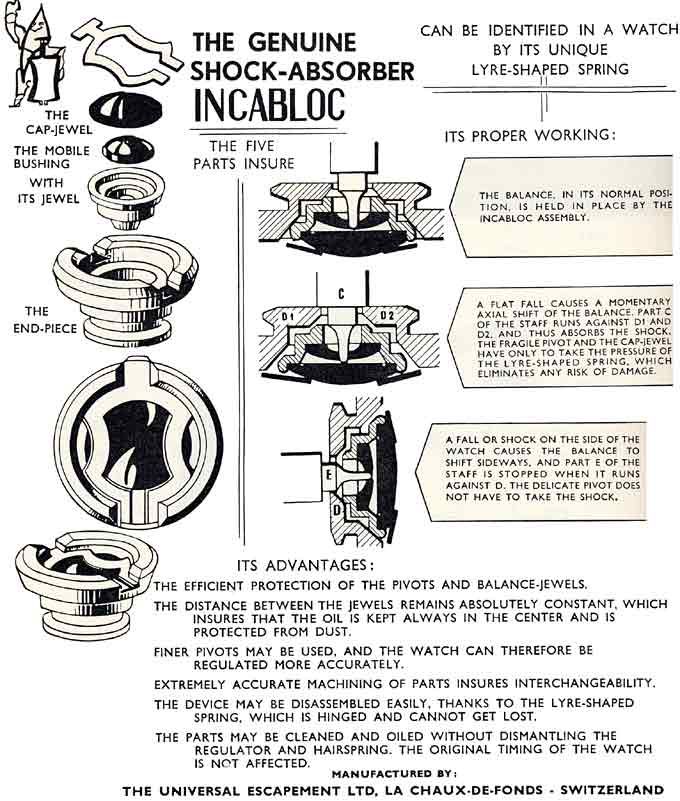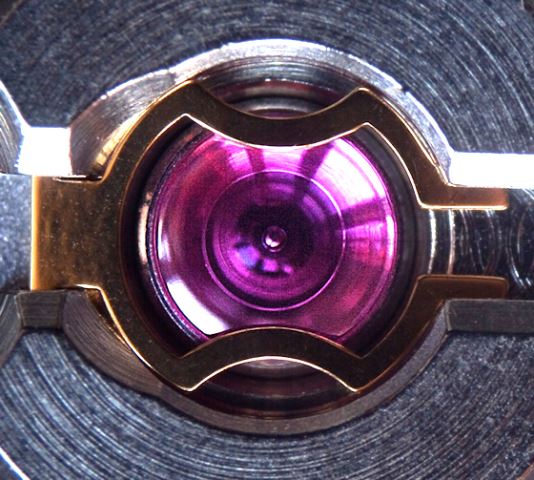Before the introduction of shock protection, one of the most common causes of a mechanical watch stopping was an impact or shock causing the balance to break. A watch balance generally has a large diameter and mass, but in order to keep friction to an absolute minimum it rotates on fine pivots. As such, were the watch to receive a knock, this combination of factors makes the balance prime for a broken pivot.
Shock protection was developed in the mid-1930s, but only started being widely used from the mid-1950s. Perhaps the most common and best known is the Incabloc system. This system is still used today and found in watches by many big names brands such as Omega. The Incabloc system is immediately recognisable, as it uses a lyre shaped spring which is clearly visible pressing down on the balance endstone.

Incabloc System
The Incabloc system is highly effective – it provides protection against shocks from all directions. It does this by allowing the chaton – in which the jewels sit (and the balance pivot rotates in the jewel hole) – to move, rather than the shock to be absorbed directly by the pivots.

Pivot jewel
Instead, a longitudinal shock’s force is taken by the balance staff shoulder, which is much stronger than the pivot, and the lyre shaped spring absorbs energy from the shock, as well as ensuring the chaton moves back into its correct position after the shock has happened. During a lateral shock the balance staff may touch the block, though this again is on a robust section of the staff. The chaton will have shifted to the side, but the sloped surfaces of the block and the retaining spring combined will ensure the chaton returns to its correct position. It really is an ingenious design – there’s a reason it’s been widely used for such a long time.
There are a huge variety of different shock protection systems, though they tend to operate based on a similar principle. Other major systems include Kif, Novodiac, Paraflex and Duofix. From a watchmaker’s perspective these vary in terms of the ease with which they can be oiled – some are straightforward, others can prove a little fiddly!
Note there are numerous other ways watches are given a form of extra shock protection, besides these shockproof balance settings. Take the Certina DS models for example. The entire movement is surrounded by an elastic shock absorber ring, designed to absorb kinetic energy caused by vibrations and shocks. When launching these models in the late 50s/early 60s, Certina use elaborate advertising to highlight the effectiveness of the protection – fixing watches to a 27kg weight and dropping them onto a concrete slab!
Do you have a mechanical watch in need of repair? Here at WE Clark Watch Repairs we are experts in the repair of all makes and models of watch – from vintage pocket watches through to modern big-name brands like Tag Heuer, Omega and Rolex. We offer a fully insured freepost watch repairs service to clients all around the UK. As holders of a Feefo Platinum Trusted Service Award and business partners of the British Horological Institute you can be confident in the service we provide.
Please Contact Us for further information regarding any requirement you may have.
Yours sincerely
David Clark DGA PJDip PJGemDip CertGA
Managing Director
W.E. Clark & Son Limited
